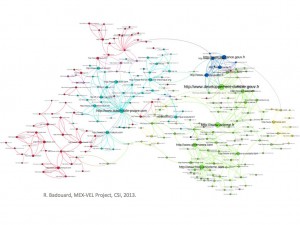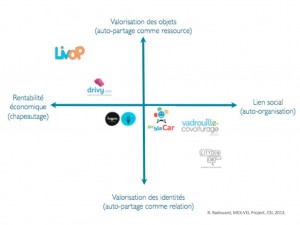At the age of “smart cities”, new uses of automobile are appearing. Nowadays, a car can be rented for a few hours, shared for the duration of a road trip or exchanged between neighbors. From a product that is owned, it has become a service that can be obtained. These new approaches of automobility are based, in part, on the on-line availability of platforms where the Internet users are invited to share their personal vehicle. Urban mobilities and on-line communities thus seem closely linked.
I was brought to work on this issue within the framework of MEX-VEL, a research project conducted at the CSI by Brice Laurent in collaboration with Martin Tironi. This project, led in partnership with the Institut de la Mobilité Durable (Sustainable Mobility Institute) and Renault, concerns the experimentation in the construction of the electric vehicle (EV) markets. My role consisted in questioning the place of the on-line communities in the production and the regulation of innovative mobility services, in the broader context of the launching of new ranges of electric vehicles into the market.
Communities of interest around the EV
This project pursued three avenues of research. The first one was an observation of the communities of interest that form on the Internet about the EV. It is well known that on-line communities are first and foremost communities of interest: the Internet users assemble because they share a common attraction for a specific theme. In order to identify these communities, I used a method meant for tracing hyperlinks. The hyperlink is indeed a good indicator of the hierarchical organization of websites within a thematic field on the Web: the websites that get many links from other websites have more authority within this thematic field and a higher degree of visibility on the Web. Thanks to softwares such as Navicrawler and Gephi, it is possible to map these links, as shown in the graph below (click on image to enlarge):
This graph discloses several phenomena. First, it shows that the issue of the EV is robust enough to generate the constitution of a community of interest as such (in blue on the map). Inside this community, the amateurs are a recognized authority: while the car manufacturers’ websites get very few links – which suggest a certain distrust of the industrialists’ arguments, the amateurs’ and fanatics’ websites have a high level of visibility and are referenced as reliable resources for the Internet users. Secondly, the theme of the EV interests other communities and allows for the creation of links between websites networks that have very few connections. It is namely the case of the themes about automobile (in red) and environment (in green). Websites relating to environmental fit less into an activist logic than those promoting “eco-responsible” lifestyles. Here, the EV seems to become part of new consumption practices, such as bio, eco-housing or sustainable consumption.
On-line communities as new methods of customer knowledge management
A second research avenue consisted in observing how on-line communities could be involved in the companies’ innovation strategies in regard to the launching of new products or services related to EV. In this context, the on-line community becomes a “calculative space” where various measurements can be made. The industrialists namely observe how a collective opinion builds up about their product or their service. Unlike focus groups that follow a similar logic, the objective here is not to measure a pre-existing opinion but to understand the mechanisms by which a common opinion stabilizes, in particular by identifying among the arguments expressed by the participants those that “hit the bull’s eye” and gain the approval of a large majority.
I have taken an interest in the customer knowledge forums set up by a communication agency which worked with Renault. The company in question adopts an original position, explicitly claiming to adhere to a deliberative approach inherited from certain currents in the American political philosophy. Within these forums, the aim is to draw the potential customers into discussions by organizing a confrontation of contradictory arguments, while moderating as little as possible the exchanges in order to let the participants express their opinions freely.
One of the conclusions of this study relates to the side effects of the creation of potential customer communities. First, the individuals who make them up appropriate the idea of community, and claim it by trying to equip themselves with external signs in order to recognize each other as members (and to be recognized as such). Secondly, creating a community is coupled with a circulation of lay knowledge: Internet users advise and help each other, provide tips to fix up charging points or to save on the vehicle batteries. The sharing strengthens the community thus formed: the community voices requirements, it even threatens the industrialists, and diverts the device to lead collective actions that were not initially planned by the organizers. Creating a community of potential customers can thus give rise to some forms of diversion of the devices set up to survey their opinions.
Interpersonal trust, a driving force of the on-line communities
The avenue I finally explored consisted of an observation of the on-line communities which emerge around carpooling and car-sharing between private individuals. With the aid of Quentin Dufour, a Master student at the University Paris-Dauphine, I compared a dozen carpooling and car-sharing services. The first conclusion of this study is that interpersonal trust is the cement of the exchanges between Internet users. For an individual to accept to rent his car to his neighbor or to share a road trip with a stranger, the establishment of a mutual trust is necessary. Trust is built on these platforms: there is a multitude of indicators, from a comment to an evaluation, from the sharing of contacts within a circle to the creation of a detailed profile, the role of which is to embody this trust in order to allow market exchange between two strangers. Sociability then becomes a major economic asset to clinch a deal: on these websites, are considered not only the punctuality or the seriousness of a driver, but also his capacity to be open, sociable, considerate towards his interlocutors and to contribute interestingly to a conversation. Lastly, the community values active Internet users, who commit themselves by spending time on the platform and who provide a significant amount of personal information. A better visibility of the participants on the website, and thus potentially new opportunities of exchange are values these types of behavior can add. The analysis of the on-line communities shows how the car becomes a mediating object within a relational network where the boundaries of the community, the density of the social relationships feeding it and the identities of the individuals composing it are simultaneously defined. (Click on image to enlarge).
A cross reflection on these various case studies focused on how participative platforms “produce” collectives by allowing them to become visible to themselves. The Internet users who assemble on these platforms as customer or seller, owner or tenant, see themselves acting within a constituted group. These platforms favor the emergence of a feeling of belonging and provide an incentive for “efficient” action thanks to the variety of profiles these communities provide.
This first stage of the MEX VEL project is coming to an end. It has produced several publications and a paper given at the 4S 2013 Annual Meeting in San Diego, last October. The second stage, led by Martin Tironi, is about the boundaries of the experiment (in the context of an electric vehicle sharing service). It aims at characterizing more specifically its constituent role in the emergence of an EV market in France.
Romain Badouard served as a Postdoctoral Research Fellow at the CSI from September 2012 to September 2013. He is now a lecturer at the University Cergy-Pontoise.
Photo #1: Twizy Way self-service car rental. Photo: Martin Tironi.
Figure #1: Mapping of the communities of interest formed around the EV on the Internet.
Figure #2: Typology of the car sharing and car-pooling services between private individuals.




